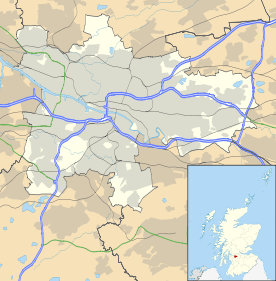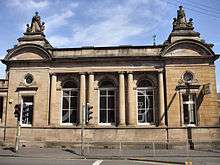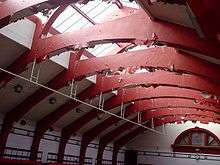Govanhill
| Govanhill | |
| Scottish Gaelic: Cnoc a' Ghobhainn | |
| Scots: Gouanhull | |
 Calder Street in Govanhill |
|
 Govanhill |
|
| OS grid reference | NS585628 |
|---|---|
| Council area | Glasgow City Council |
| Lieutenancy area | Glasgow |
| Country | Scotland |
| Sovereign state | United Kingdom |
| Post town | GLASGOW |
| Postcode district | G42 |
| Dialling code | 0141 |
| Police | Scottish |
| Fire | Scottish |
| Ambulance | Scottish |
| EU Parliament | Scotland |
| UK Parliament | Glasgow Central |
| Scottish Parliament | Glasgow Southside |
Coordinates: 55°50′15″N 4°15′40″W / 55.837610°N 4.261055°W
Govanhill (Gaelic: Cnoc a' Ghobhainn) is a district in the Scottish city of Glasgow. Historically part of Renfrewshire, it is situated south of the River Clyde between the Gorbals, Pollokshields, Crosshill and Queen's Park. The council ward has boundaries of Dixon Avenue and Dixon Road to the South, Victoria Road to the West, Butterbiggins Road to the North, and Aikenhead Road to the East.
History

The history of the area is linked to the Dixon family. A prominent ironmaster, William Dixon opened blast furnaces to the north of Govanhill which became known as Dixons Blazes. A company village called Fireworks Village was situated on the site of the later Burgh of Govanhill. The area itself was formed in 1877 and the main avenue that runs the length of it is called Dixon Avenue. Some of the local streets were named after the daughters of William Dixon Jnr: Allison Street, Daisy Street, and Annette Street.
From the first days of the neighbourhood's formation, Govanhill has always been a popular settlement area for people coming to Glasgow and Scotland. The population has regularly changed and diversified as migrants have chosen to live in the area. Migration started with people from the Highlands and Lowlands of Scotland; from Ireland; Jewish people fleeing persecution in Eastern Europe; people from the Punjab and other parts of the Indian sub-continent; Glasgow's new communities of former asylum seekers and refugees and – most recently – economic migrants benefiting from EU enlargement from Poland, Slovakia, the Czech Republic and Romania. This diversity is reflected in the local shops, the languages spoken in the street and in the people found locally. A recent social survey found that 53 languages were spoken in only 13 of the area's housing blocks. The area has long been Scotland's most culturally diverse neighbourhood. Of the 15,000 people living in the neighbourhood, approximately 40% are from ethnic minority communities, with Roma from Slovakia, the Czech Republic and - increasingly - Romania making up 3,000-3,500 of the local population.
Govanhill was one of the few areas to avoid Glasgow Corporation's programme of 'Comprehensive Development Areas' in the 1960s. A total of 29 inner city areas were identified for complete demolition and replacement with new buildings. The existing communities were dispersed – normally to the new estates at the edge of Glasgow or to Scotland's new towns – e.g. East Kilbride, Cumbernauld. The replacement housing was high rise or deck access and non-traditional. Few community facilities were provided initially and little thought was given to the replacement of the elaborate infrastructure of shops, pubs and small businesses which were an integral part of the previous tenement structures.
Some Govanhill locals did not like what they saw happening to other communities across the city and decided to take matters into their own hands. Based on early experience in Govan, a community based Housing Association[1] was established in 1974, run by the residents living in the area. Instead of mass demolition, a steady process of improving the quality of the flats and installing modern amenities was undertaken. This was complemented by sensitive new building in gap sites.
Changes in policy and funding meant that the refurbishment of Govanhill's tenement housing was not completed. 13 housing blocks in the south west of the district remain 'unimproved'. It is in this area that the most significant housing problems in Govanhill appear – poor-quality housing stock, over 2,000 private landlords, low levels of owner occupation, low levels of factoring/property management and overcrowding.
Govanhill is home to one of Glasgow's original Carnegie libraries, designed in the Edwardian Baroque style by James Robert Rhind.[2]
Community
Due to housing density, increases in population through migration, overcrowding and high levels of occupancy, the south west of Govanhill is one of the most densely populated areas in Scotland. This places strain on local infrastructure and adds to community tensions, environmental problems and other social issues. Despite this focus on the south west of the district the highest levels of multiple deprivations exist within North Govanhill, particularly in the predominantly social housing area to the east of Cathcart Road. As of December 2012 the Scottish Index of Multiple Deprivation (SIMD) and other sources indicates that:
- 4 of the 12 data zones making up Govanhill are within the bottom 15% of data zones in Scotland. One of these data zones occupies the bottom 5% of data zones in Scotland
- 3,796 (25.6%) of the adult population is described as 'income deprived', whilst 2,300 (22.5%) of those of employment age are 'employment deprived'.
- 38.2% of adults do not have any qualifications.
- Life expectancy is four years lower than Scotland's average
- Instances of violent crime are 159% above the Scottish average with domestic abuse incidents and drug offences 45% and 73% above.
Govanhill has long been recognised as one of Scotland's deprived communities and this continues to be borne out in SIMD 2012. All but 3 of the area's 12 datazones fall into the bottom 30% of all Scottish datazones. Of these 9 datazones, 5 fall into the bottom 15% of Scottish datazones, with 4 datazones in the bottom 10%. This indicates particularly acute deprivation in much of the neighbourhood.
Govanhill's most deprived datazones are typically found in the Govanhill East and Aikenhead part of the district. Four of the five lowest ranked datazones in Govanhill can be found in this area, all in the bottom 15% of Scottish datazones. One other datazone in the bottom 15% can be found in Govanhill West.
In addition to the above, all but two of Govanhill's SIMD datazones occupy the bottom 15% of datazones in Scotland in terms of income.
Attractions
Govanhill is home to a thriving creative arts community, including Dance Factory Dance Studios[3] in Calder Street, Twisty-Headed Man Company[4] on Butterbiggins Road and a variety of arts activities taking place in Govanhill Baths. The Chalet in Dixon Avenue and Southside Studios in Westmoreland Street are both home to successful visual artists and other creatives. Since 2009, the area has had its own arts festival - Streetland, which usually takes place in early summer in streets and venues across the area. Govanhill Housing Association[1] also organises an annual Fun Day for local residents. The Fun Day and Streetland Festival next take place on 6 June 2014.
There is a vibrant voluntary sector in the local community with dozens of organisations active in the area. Considerable activity exists to improve the environment, engage young and old, promote integration, tackle addictions, develop the arts, provide education and develop opportunities locally. There are many opportunities to volunteer locally. At the local neighbourhood centre there is a considerable array of leisure and other activities which people can get involved in.[5]
Govanhill is also famous for its shops, which in themselves reflect the huge diversity of the area. There are a number of businesses supporting international connections – money transfer businesses, cargo services, travel agencies – as well as clothing and food stores for all nationalities. The area is also home to a number of traditional shops – cobblers, school uniform suppliers, cafes etc. – but planning approval has also recently been granted for a mixed leisure and retail development at the soon to be vacated bus garage near Eglinton Toll.
The area is home to many faith communities, with churches, mosques and synagogues often in close proximity or side by side. Faith communities are often delivering significant community services as part of their core work and this activity often goes under the radar. Local churches are involved in delivering services to homeless, those in food poverty, children and families, street workers, elderly and those experiencing isolation and loneliness. Local faith communities also provide a number of drop-in cafes or free meals and have been instrumental in establishing the local food bank, as well as meeting the impacts of Welfare reform.
Govanhill Baths

The baths were designed by A B McDonald and opened in 1917 after the architect's death. They contained hot baths in the upper storey and three swimming pools on the ground floor. There was a seating gallery around one of the pools for spectators attending events such as galas. There was also a wash-house or "steamie" at the rear of the building, which was converted to a launderette in 1971.
For many years, the usage of the baths was in sharp decline, with access to the general public being severely limited by "specialist" sessions where only certain members of the paying public were allowed in, and as a general amenity they proved to be non-viable. After the council closed the baths, the campaign to save Govanhill Baths began in December January 2001 which resulted in an occupation of the building by left-wing activists from 17 March until 7 August 2001 when Sheriff's Officers accompanied by police removed the protesters and boarded up the pool. Since then, a growing community has continued campaigning for the redevelopment and reopening of the facilities to residents of Govanhill and surrounding communities. The Govanhill Baths Community Trust[6] organises fundraising events, sends out regular newsletters and runs the Govanhill Baths Open days in which members of the public are shown round the building for free.
The baths were reported to be a venue for the Big Huge Poetry Splash in 2012, as part of National Poetry Day.[7]
Elected representatives
- Member of Parliament: Alison Thewliss (Glasgow Central)
- Member of Scottish Parliament: Nicola Sturgeon (Glasgow Southside)
- Members of Scottish Parliament (City-wide): Ruth Davidson, Bob Doris, Patrick Harvie, Anne McTaggart, Hanzala Malik, Drew Smith, Humza Yousaf
- Scottish Members of European Parliament: Ian Hudghton, David Coburn, David Martin, Alyn Smith, Ian Duncan, Catherine Stihler
- Glasgow City Council Ward 8 - Southside Central: Councillor Jahangir Hanif, Councillor Mhairi Hunter, Baillie James Scanlon, Councillor Soryia Siddique
References
- 1 2 "Govanhill Housing Association".
- ↑ http://www.glasgowlife.org.uk/libraries/your-local-library/govanhill-library/Pages/home.aspx
- ↑ "Dance Factory Dance Studios".
- ↑ "Twisty-Headed Man Company".
- ↑ "Govanhill Neighbourhood Centre".
- ↑ "Govanhill Baths Community Trust".
- ↑ Provan, Gillian (27 September 2012). "Writers bring poetry to life in the heart of the city's famous landmarks". STV. Retrieved 27 September 2012.